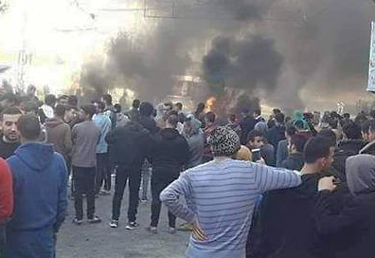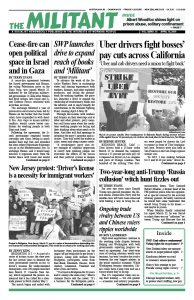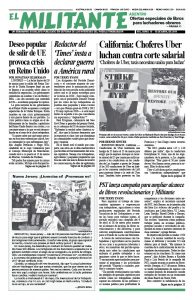
A cease-fire agreement between the Israeli government and Hamas, the ruling Palestinian party in the Gaza Strip, was signed March 25, brokered by the Egyptian military-led government. It came after Hamas had fired rockets into Israel and Israel Defense Forces retaliated with airstrikes on Gaza.
The exchange followed a year of provocative anti-Israel actions led by Hamas on the border that the Israeli rulers have responded to with deadly fire. Any steps to lessen military conflicts would create better conditions for working people in both Gaza and Israel.
Following the agreement, the Israeli government reopened border crossings into Gaza, letting in much needed food and fuel and extended the areas where Palestinian fishermen can go in the Mediterranean Sea. In exchange Hamas said it would keep marches it organizes away from the border fence with Israel and would prevent the launching of incendiary kites that have burned farmland in southern Israel in recent months.
During these protests Hamas has urged participants to try and breach the border. When the Israel Defense Forces respond with lethal force, Hamas seeks to utilize the subsequent deaths to win support against Israel in bourgeois public opinion. Some 260 Palestinians have been killed and 7,000 wounded, mostly by Israeli sniper fire, since Hamas initiated the confrontations.
Four Palestinians were killed March 30, when over 40,000 gathered to mark the one-year anniversary of the weekly March of Return protests. Hamas operatives largely prevented marchers from approaching the border fence.
Hamas, with roots in the Muslim Brotherhood and on-again, off-again ally of the rulers in Tehran, took control of Gaza in 2007. Since then it has fought three wars with Israel. Its stated goal is to drive all Jews out of Israel and Palestine.
But Hamas’ Jew-hatred, provocations and disdain for Palestinian lives have made it increasingly isolated. The group today faces unrest inside Gaza as it offloads the economic crisis onto working people. Youth unemployment stands at 65 percent. The hardship facing workers and farmers is intensified by the blockade imposed by the governments of Israel and Egypt. After Hamas hiked taxes on food and cigarettes working people and youth protested the measures in several areas of Gaza March 14 and for days afterward.
Demonstrators carried signs that read, “Down with price hikes” and “I want to live in dignity.” Cops dispersed protesters and arrested over 1,000 people.
Tehran orders attacks on Israel
The day the Israeli government and Hamas agreed upon the cease-fire, another rocket was fired from Gaza and struck Mishmeret, north of Tel Aviv, injuring seven people. Hamas and Egyptian officials say the attack was carried out by Palestinian Islamic Jihad based in Gaza, under orders from the Iranian government. In recent years the rulers in Iran have decreased their funding of Hamas and boosted the coffers of Islamic Jihad, considering its leaders more compliant in carrying out attacks on Israel in hopes of scuttling any peace deal between Hamas and Tel Aviv.
Tehran fears that any reduction in military tensions between Israel and Gaza will allow the Israeli rulers to focus more intently on their bombardment of military bases Tehran has established across neighboring Syria. The rulers in Iran took advantage of the brutal war conducted by Syrian dictator Bashar al-Assad to move forces into that country.
In the 1980s the Iranian capitalists used brutal repression to consolidate their class rule and defeat struggles by workers, farmers, women, Kurds and other oppressed nationalities that had opened up during the 1979 Iranian Revolution that overthrew the U.S.-backed shah. The Iranian rulers have sought for decades to increase their clout across the region, extending abroad the counterrevolution they carried through against working people at home.
Tehran’s intervention around the region is a deadly obstacle to working people advancing their interests. A statement by the Socialist Workers Party National Committee issued in December 2017 explains that talks to recognize both Israel and an independent Palestinian state “must recognize the right of Jews everywhere to take refuge in Israel in face of the global rise of Jew-hatred and anti-Semitic violence, as well as the unconditional right of the dispossessed Palestinian people to a contiguous, sovereign homeland on territory … conquered and occupied by the Israeli government during the 1967 war.” (The entire statement is available on the Militant’s website.)
President Donald Trump recognized Israeli sovereignty over the Golan Heights March 21. The Israeli military has occupied the area since the end of the 1967 Six-Day War.

